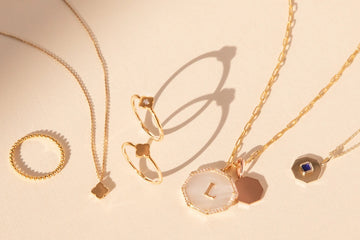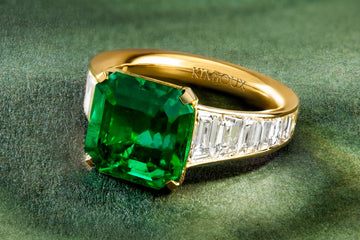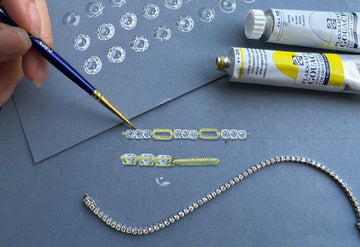
As humans we are always striving to achieve beauty and perfection whether through cosmetic surgery or natural treatments. Some treatments can last forever while others just give us a boost for a short time.
Similarly, gemstones can be treated using many different methods to enhance their natural beauty. The very first documentation of gemstone treatment was presented thousands of years ago by Pliny the Elder, commander of the early Roman Empire, renowned author, naturalist and philosopher. So the process of treating and enhancing precious gems is an ancient tradition that dates back thousands of years which is still practiced today.
Without gemstone enhancements many of the most popular gemstone types would not be available today or even exist, such a London Topaz. It may be hard to imagine, but the rainbow of available gemstones we take for granted today wouldn’t exist without various forms of treatments.
It is common knowledge within the industry that the majority of emeralds, rubies and sapphires are in some way enhanced or treated. Only the very pure, perfectly coloured and flawless can escape any type of enhancement, and this is reflected in their record-breaking prices.

Whilst heat treatment is globally the most common and widely accepted treatment within the gemstone trade, there are plenty of other common applications to both crystalline and organic gem materials:
-
Surface Modification
-
Fracture/Cavity Filling
-
Heat Treatment
-
Diffusion
-
Impregnation
-
Irradiation
-
Laser Drilling
-
Oiling
-
Dyeing
-
Bleaching
The most common treatments for the ‘big three’ are heat treatment with or without irradiation, oiling, diffusion and cavity and fracture-filling. Of these, heating and oiling are the most widespread and when applied correctly and disclosed are acceptable enhancements. Cavity and fracture filling are, by the nature of the treatment, applied to lower quality stones. They enhance material that would otherwise be extremely fractured and are acceptable but without the correct care the effects don’t last forever so special care must be taken when cleaning jewels subjected to these treatments. Diffusion that alters the colour of a stone at its crystal lattice level. This can penetrate the whole stone or just at surface level but must be disclosed as it lowers the value of the stone and is very hard to detect. Often if a stone of value is suspected to have been subjected to this it is usually referred to a laboratory for confirmation.
Let’s take a close look at the most common treatments and how to spot them!

The majority of sapphires and rubies are heat-treated, in fact, un-heated natural stones are rare so assume they are heated until proven otherwise with a report from a respected laboratory such as the SSEF, GIA, AGL, Gübelin or GRS.
Sapphires considered too dark can be lightened or the near colourless ones can be given a deeper hue. Undesirable tones such as brown in ruby can be removed and heat treatment can even be used to create ‘star stones’ in some sapphires that readily contain enough titanium. Heat treatment can remove, generate or alter the appearance of a stone’s inclusions. The temperature, environment, additional chemicals, time of exposure and rate of heating and cooling all influence the stone’s resulting characteristics. Difficult to spot without gemmological training, evidence of heat treatment can sometimes be detected by a trained eye with a loupe and/or microscope.
SURFACE MODIFICATION
This is often the easiest treatment to spot with the naked eye.
When the stone is flipped over and viewed table-down you may see modifications include coatings and backings (like reflective foils or metallic films) that have been used for thousands of years and are frequently seen in inexpensive costume jewellery.
Use was so widespread during the Renaissance that laws were made to ban such treatments. Coloured coatings or layers of coloured dyes can deceptively enhance the look of stones like emerald. Whenever looking at a piece, it is important to view it from all directions to check for these tricks. You may notice chipping/peeling to the coating at the sharp edges of the facets, where the colour/added foil is removed. Stones often have an ‘unnatural’ appearance when viewed face up. Any stone can be subjected to this, from glass right through to diamonds!

Just like our teeth, gemstones can have cavities or ‘fractures’ that can be sealed. Fractures in stones lessen their desirability because they both create an optical void and can also greatly weaken the durability of a stone which is why it is advantageous to conceal them and improve the stones optical coherence and durability to an extent.
The stone may be bleached in the process to remove any residual staining in the cavities. The hardness and lustre of the flux, resin or glass filler may well differ greatly to the host stone, for example ruby, and this disparity can be seen with the help of a jeweller’s loupe under a bright light source. The filler may also produce specific colours of light flashes when rotated under a high powered light and this can also be a good indicator of the treatment. This should always be disclosed to the buyer, as any heat applied to the stone (for example the jeweller’s torch if the item is in for repair) can completely destroy the treatment and subsequently render the stone fairly worthless.
FRACTURE FILLING
This is similar to cavity filling, but while cavities are usually wide and drastically reduce the appeal of the material, fractures are slender and narrow. The fractures must be surface reaching for the treatment to be able to take place.
The most commonly fracture-filled gems are emerald and ruby. Once the fillers of Flux, glass, polymer or resin are applied by various methods, the fissures are fairly well disguised. As alluded to earlier, caution must be taken if purchasing a fracture filled or oiled stone, as the fillings and oils can be removed with cleaning, sudden temperature change and even contact with cosmetics, perfumes, hairspray and common household chemicals. Fracture filling may slightly enhance the durability of a stone but it is most commonly done to enhance the visual appearance.
OILING
Oiling does no harm to the stone and is reversible. It has been recorded as far back as Ancient Egypt and is acceptable and common, especially in emeralds.
An oil is applied to stones to reduce reflection from fractures, improving the stones perceived clarity. A coloured oil may greatly enhance colour however oils will not enhance the durability of the stone. Oiling (with or without dye) and wax or resin coating is also very commonly applied to decorative material such as turquoise and jade. Even opals are sometimes oiled to hide crazing of the surface. Detection is not easy and usually requires examination with a microscope by a gemmologist. As noted above, extreme care must be taken with oiled stones not to expose them to harsh chemicals or sonic or steam cleaners. Oils can also dry out or dehydrate over time.

elements penetrate either the surface or even the whole body of the stone. This is done to enhance the stones colour, change it entirely or induce the creation of star stone. This treatment is frequently used in sapphires to create the highly rare, naturally occurring variety known as Padparadscha, which has the colour of a lotus flower. As technology has advanced this treatment has become harder to detect. A wide variety of colours can now be created through diffusion and if suspected it often needs referring to a laboratory for confirmation.
To conclude, if you are looking for an affordable piece of jewellery to wear often and enjoy, treated stones are perfectly acceptable if the seller has been transparent about the enhancement the stone has received and you fully appreciate any implications that the treatment creates surrounding care and wear of the stone. They can be a great price point and allow people to buy stones that may otherwise be beyond their price range such as padparadschas sapphires.
Nonetheless, if you are on the hunt for an investment piece or an item to last lifetimes, the less treatment, the better. If you are buying a treated stone its imperative to understand the care implications of the stone that are due to the nature of the particular treatment. For example If you knowingly buy a treated stone, especially if accompanied by a certificate and then do not disclose the treatment fully to a jeweller if you take the item in for repair, you would be at fault should any harm come to the stone from the repair process.
To assist you on your buying journey below are some questions you might consider asking to ensure you get exactly what you want:
1. Has the stone been treated?
2. If so, what benefit did the treatment have on the stone?
3. How did the treatment affect the value?
4. Is there a report documenting the treatment?
5. Does the stone require any special care?
7. What is the safe way to clean and care for the jewellery?
8. If the stone was re-set into a different setting, would there be any risk of damaging the stone?
9. Is the level of wear you wish from the stone (e.g. everyday wear) compatible with any compromise of the stones stability/durability as a result of any treatments?
Get in touch if you need help looking for the perfect gemstone for your next heirloom piece.











